Unveiling the Hidden Stories in Other Lesser-Known Constellations
Contents
- Exploring Lesser-Known Constellations
- Constellation #1: Vulpecula the Fox
- Constellation #2: Antlia the Air Pump
- Constellation #3: Columba the Dove
- Constellation #4: Delphinus the Dolphin
- Conclusion
-
Frequently Asked Questions
- 1. How are constellations formed?
- 2. Are constellations visible all year round?
- 3. Can constellations change over time?
- 4. Are there constellations in both the northern and southern hemispheres?
- 5. How were constellations named?
- 6. Can constellations be seen in urban areas with light pollution?
- 7. Are there any famous stars within lesser-known constellations?
- 8. Can lesser-known constellations be used for navigation?
- 9. Are there connections between lesser-known constellations and astrology?
- 10. Are there any ongoing scientific studies or missions related to lesser-known constellations?
- References
-
Frequently Asked Questions
- 1. Why are constellations important in astronomy?
- 2. Are lesser-known constellations visible to the naked eye?
- 3. How were the constellations named?
- 4. Can I see lesser-known constellations from different locations on Earth?
- 5. What are some modern applications of studying lesser-known constellations?
- 6. Are there any scientific discoveries associated with lesser-known constellations?
- 7. Can I create my own constellations?
- 8. How can I locate and identify lesser-known constellations?
- 9. Are there any lesser-known constellations that are specific to certain cultures?
- 10. Can studying lesser-known constellations help us appreciate the vastness of the universe?
- References
- Read More
Exploring Lesser-Known Constellations
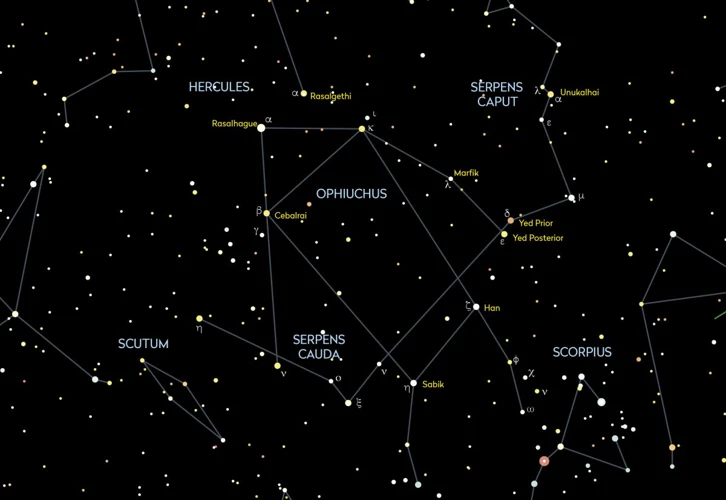
When it comes to stargazing and navigating the night sky, popular constellations like Orion, Ursa Major, and the Big Dipper often take center stage. However, there is a whole celestial world filled with lesser-known constellations waiting to be discovered. These hidden gems may not have the same level of recognition, but they have their own fascinating stories and symbolism that captivate the imagination. By venturing beyond the familiar, we can uncover a wealth of knowledge and unravel the mysteries of the cosmos. So, let’s embark on a journey to explore these lesser-known constellations and dive into their hidden tales of myth, history, and scientific significance.
Whether it’s Vulpecula the Fox, Antlia the Air Pump, Columba the Dove, or Delphinus the Dolphin, each of these constellations has a unique narrative to share. From connecting ancient mythology to modern astronomy, these celestial formations will amaze and inspire us with their rich cultural heritage and scientific relevance. So, let us set our sights on these lesser-known constellations and unravel the hidden stories that have been written among the stars. But before we delve into each individual constellation, let’s first understand the origin and importance of constellations as a whole.
The Origin and Importance of Constellations
Constellations have been an integral part of human history and culture for thousands of years. The origin of constellations can be traced back to ancient civilizations, who used these patterns of stars to navigate and mark the passing of seasons. These captivating arrangements of stars sparked the imagination of early astronomers and storytellers, leading to the creation of elaborate mythologies and celestial narratives. The importance of constellations extends beyond their navigational and storytelling purposes. Constellations have played a significant role in shaping our understanding of the cosmos and have been instrumental in the development of modern astronomy. Through the study of constellations, astronomers have been able to identify and classify stars, map out the celestial sphere, and even discover new celestial objects. To truly grasp the significance of constellations, it is crucial to explore their mythological origins, their connection to ancient cultures, and their contributions to our scientific understanding of the universe. This understanding will provide a deeper appreciation for the wonders that await us as we venture into the lesser-known constellations. If you’re interested in unraveling the stories behind the constellations, you can check out mythological constellation stories or explore the mysterious Ophiuchus constellation with its intriguing backstory rooted in Egyptian mythology found in the Book of the Dead.
Popular Constellations vs. Lesser-Known Ones
While popular constellations like Orion and the Big Dipper are widely recognized and have been prominent in various cultures throughout history, lesser-known constellations often go unnoticed by the casual stargazer. The popularity of certain constellations can be attributed to their visibility in the night sky, their association with well-known myths or legends, or their prominence in cultural traditions. However, overlooking the lesser-known constellations means missing out on a treasure trove of celestial wonders.
The allure of exploring lesser-known constellations lies in the opportunity to uncover unique stories and symbols that may be less familiar but are just as captivating. These constellations often have fascinating mythological backgrounds, cultural significance, and scientific relevance that offer a fresh perspective on our connection to the cosmos. By expanding our knowledge beyond the popular constellations, we can gain a deeper understanding of the vastness and diversity of the universe.
It is important to remember that the distinction between popular and lesser-known constellations is not a measure of their true worth or significance. Each constellation, regardless of its popularity, has its own beauty and intrinsic value. By embracing the lesser-known constellations, we can broaden our horizons and develop a more comprehensive appreciation for the wonders of the night sky. So, let’s set aside our preconceptions and embark on a journey to explore the hidden gems among the stars.
Constellation #1: Vulpecula the Fox
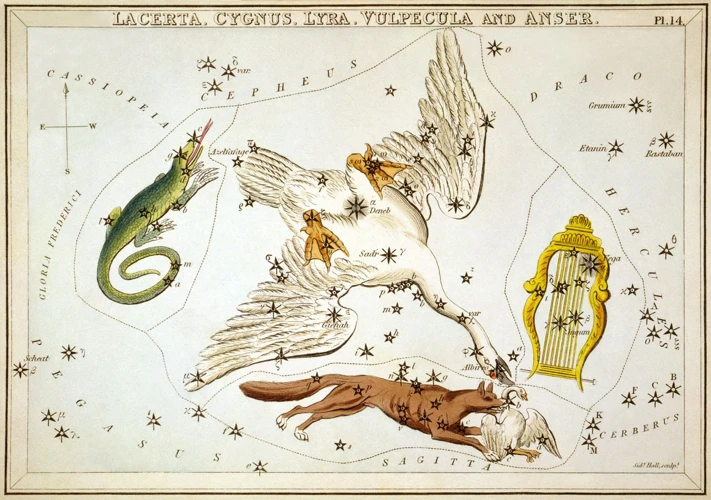
Vulpecula the Fox is a lesser-known constellation that holds an intriguing place in mythology and symbolism. Its name derives from the Latin word for “little fox.” According to ancient mythology, the constellation represents a fox that was sent by Jupiter to retrieve grapes for a feast. However, the fox was unable to reach the grapes and, in frustration, jumped up and down trying to reach them, creating the stars that form the constellation.
Interesting Facts and Figures:
1. Location: Vulpecula can be found in the northern sky, neighboring the constellations Cygnus and Lyra.
2. Visual Appearance: Vulpecula is a relatively small constellation, consisting of faint stars that form the shape of a fox. It is best viewed under clear, dark skies away from city lights.
3. Historical Significance: Vulpecula was one of the 48 constellations listed by the astronomer Ptolemy in his influential work, the Almagest, which catalogs the stars and constellations known in ancient times.
4. Deep-Sky Objects: One notable feature within Vulpecula is the Dumbbell Nebula (also known as Messier 27), a planetary nebula that resembles a glowing dumbbell. It is one of the brightest objects of its kind and can be observed with a telescope.
5. Modern Research: In recent years, Vulpecula has been a target for scientific research due to the presence of exoplanets within the constellation. The discovery of planets orbiting stars in Vulpecula has contributed to our understanding of planetary systems beyond our own.
As we unveil the hidden stories within Vulpecula the Fox, we can appreciate the significance of this lesser-known constellation in both mythological tales and scientific exploration. Its enigmatic presence among the stars serves as a reminder of the vastness and wonders of the universe.
Mythological Origins and Symbolism
Every constellation carries a unique mythological origin and symbolism, and Vulpecula the Fox is no exception. According to Greek mythology, this constellation represents the fox that distracted the hounds while the hero Heracles (Hercules) was in pursuit of the Teumessian Fox, another constellation. The story goes that the Teumessian Fox was destined never to be caught, and the gods sent the fox to distract Heracles, preventing him from completing his labor. Vulpecula, the lesser-known constellation, portrays the clever fox that played a pivotal role in this legendary tale.
The symbolism of the fox in Vulpecula stretches beyond its mythological origins. The fox has historically been associated with wit, cunning, and adaptability. In various cultures, it has also been linked to slyness, secrecy, and transformation. The ancient Egyptians, for example, considered the fox to be a symbol of intelligence and regarded it highly in their mythology. Today, the fox’s symbolism in Vulpecula reminds us to embrace our own cleverness, adapt to changing circumstances, and navigate the complexities of life with grace and agility.
Exploring the mythological origins and symbolism of constellations like Vulpecula not only connects us to ancient stories and cultures but also offers deeper insights into our own human experience. It allows us to witness the intricate relationship between mythology, symbolism, and the wonders of the celestial world. The next time you gaze up at the night sky, try to locate the constellation Vulpecula and let its mythical tale and symbolism spark your imagination.
Interesting Facts and Figures
Now that we have uncovered the mythological origins and symbolism behind Vulpecula the Fox, let’s dive into some fascinating facts and figures about this lesser-known constellation.
One intriguing fact is that Vulpecula is home to the famous Dumbbell Nebula, also known as Messier 27. This nebula is a large, glowing cloud of gas located approximately 1,360 light-years away from Earth. Its distinct dumbbell shape makes it a popular target for amateur astronomers.
Another interesting aspect of Vulpecula is its relatively small size. It is one of the smallest constellations in the night sky, occupying an area of just 268 square degrees. Despite its diminutive size, Vulpecula holds great significance in scientific research, particularly in the field of variable star observations.
Vulpecula is also associated with the discovery of pulsars, which are rapidly rotating neutron stars that emit regular pulses of radio waves. In 1967, the first pulsar, known as PSR B1919+21, was discovered within the boundaries of Vulpecula. This discovery opened up new possibilities for studying the nature of neutron stars and expanded our understanding of the universe.
Vulpecula is home to several other notable celestial objects, including the Coathanger Cluster (also known as Brocchi’s Cluster) and the open star cluster NGC 6823. These objects provide astronomers with valuable insights into stellar formation and evolution.
By exploring these interesting facts and figures, we can appreciate the intricate beauty and scientific significance of Vulpecula. It reminds us that even the lesser-known constellations have hidden wonders waiting to be uncovered and studied.
Constellation #2: Antlia the Air Pump
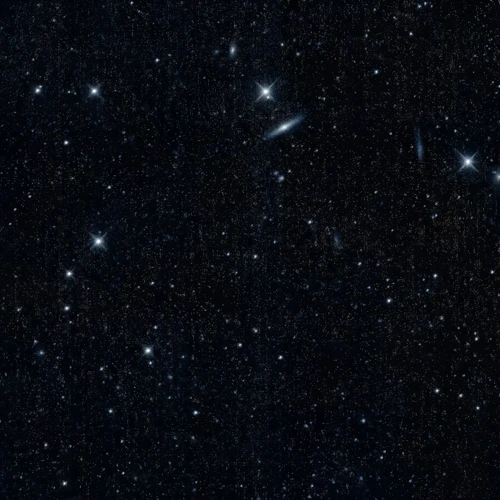
Antlia the Air Pump is a lesser-known constellation that was introduced in the 18th century by the French astronomer Abbé Nicolas Louis de Lacaille. Its name, “Antlia,” is derived from the Greek word for “pump.” This unique constellation represents an air pump, a device used to create a partial vacuum and explore the properties of gases.
While Antlia may not have a rich mythology like other constellations, it holds historical significance as one of the constellations added to the night sky during the era of scientific exploration. It serves as a tribute to the advancements in scientific knowledge during the Enlightenment period.
Antlia spans over 238 square degrees and is located in the southern sky, making it more visible from the southern hemisphere. One notable feature of Antlia is its faint stars, which require dark skies and minimal light pollution to observe clearly.
In terms of modern relevance, Antlia is not associated with any prominent celestial objects or deep-sky wonders. However, it can serve as a guidepost to locate nearby galaxies and star clusters. Its position between Hydra and Centaurus makes it a helpful marker for astronomers studying celestial objects in that region.
While Antlia may not have a flashy mythological backstory, it still holds its place among the lesser-known constellations, reminding us of the scientific discoveries and advancements that have shaped our understanding of the universe. Exploring Antlia the Air Pump allows us to appreciate the wonders of the night sky from a scientific perspective and highlights the diverse stories and symbols that can be found within the astronomical tapestry.
Historical Background and Naming
Antlia, the Air Pump, may be lesser-known, but its historical background and naming tell a fascinating story. This constellation was first introduced by the French astronomer Abbé Nicolas Louis de Lacaille in the 18th century during his astronomical expeditions in South Africa. Inspired by scientific instruments, he named the constellation “Antlia Pneumatica” to honor the invention of the air pump, which was a significant technological advancement during that time.
The naming of Antlia reflects the transition from mythological figures to scientific instruments as sources of inspiration for constellations. It symbolizes the growing influence of scientific discoveries and technological progress in shaping our understanding of the universe. By associating constellations with scientific tools, astronomers pay homage to the human quest for knowledge and innovation.
Antlia’s historical background stands as a testament to the evolving nature of our understanding of the night sky. It represents a bridge between ancient mythological stories and modern scientific exploration. In this way, Antlia serves as a reminder of how our understanding of the cosmos has evolved over the centuries and continues to expand with each new astronomical discovery.
Unique Features and Modern Relevance
Antlia the Air Pump may not be as well-known as some other constellations, but it has its own set of unique features and modern relevance. One distinctive characteristic of Antlia is its shape, resembling an antique air pump used in the 18th century. The constellation was named by Abbé Nicolas-Louis de Lacaille, a French astronomer, during his astronomical observations in the Southern Hemisphere.
In terms of modern relevance, Antlia is home to a few notable objects of interest. One such object is the Antlia Dwarf galaxy, located within the boundaries of the constellation. The Antlia Dwarf is a small irregular galaxy that has captured the attention of astronomers due to its relatively close proximity to the Milky Way.
Antlia is also host to a unique variable star, known as R Antliae. This star is classified as a carbon star, characterized by its high abundance of carbon in its atmosphere. Carbon stars play a crucial role in the chemical enrichment of the universe as they release carbon-rich materials into space through their stellar winds.
In addition to its celestial objects, Antlia also holds symbolic significance in modern times. It serves as a reminder of the cultural and historical advancements in the field of astronomy. By exploring lesser-known constellations like Antlia, we can broaden our understanding of the vast universe and appreciate the hidden wonders that lie beyond the popular constellations we often encounter.
Let us continue our journey and delve into another intriguing lesser-known constellation: Columba the Dove.
Constellation #3: Columba the Dove
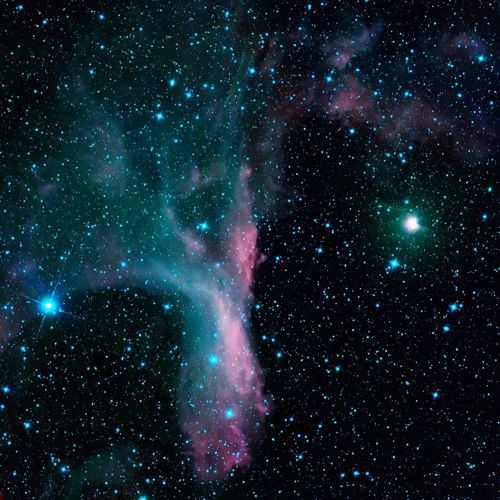
Columba the Dove is a lesser-known constellation that holds great cultural significance and has roots in ancient mythology. In Greek mythology, Columba is associated with the story of Noah’s Ark, where the dove played a crucial role in signaling the end of the Great Flood and the beginning of a new era. The constellation represents the dove that Noah released to search for dry land, symbolizing hope, peace, and new beginnings.
In addition to its mythological connections, Columba has also made its mark in modern astronomy. The dwarf irregular galaxy known as Columba’s Blue Compact Dwarf is located within this constellation. It is a small, faint galaxy that is of particular interest to astronomers due to its active star-forming regions and young stellar population. This celestial formation offers valuable insights into the processes of galaxy evolution and the formation of stars.
Exploring Columba the Dove not only allows us to delve into ancient mythologies, but it also uncovers the wonders of our universe. It reminds us of the powerful stories hidden within these lesser-known constellations and the mysteries that continue to unfold as we gaze at the vast expanse of the night sky. By connecting the past and the present, Columba serves as a reminder of the enduring nature of human imagination and our quest to understand the cosmos.
Cultural Significance and Ancient Mythology
Columba the Dove, a lesser-known constellation in the night sky, holds immense cultural significance and is intertwined with ancient mythology. In different cultures and civilizations, doves have often symbolized peace, love, and hope. In Greek mythology, Columba is associated with the story of Noah’s Ark, representing the return of peace and life after the Great Flood. According to Greek lore, Columba guided the ship to land by carrying an olive leaf, signaling the end of turmoil and the beginning of prosperity.
In Egyptian mythology, the dove was associated with the goddess Hathor, who was a symbol of love, joy, and motherhood. Hathor was often depicted with a dove perched on her head or as a dove herself. It was believed that the dove served as a messenger between humans and the gods, bringing blessings and divine guidance.
In Native American folklore, the dove is revered as a sacred bird. It is seen as a symbol of purity, spirituality, and connection with the spirit world. Native American tribes believe that the dove carries messages from the ancestors and acts as a guide for individuals seeking wisdom and enlightenment.
The cultural significance of Columba and its connection to ancient mythology reveal the universal human fascination with birds and their symbolic meanings. These stories remind us of the rich tapestry of human history and the way constellations have served as a canvas for our imagination and beliefs throughout the ages. Thus, when we look up at the stars and spot Columba, we are not just gazing at a random arrangement of stars; we are witnessing a beautiful representation of ancient stories and cultural heritage.
Connections with Modern Astronomy
The constellation Columba the Dove may have ancient mythological origins, but it also holds relevance in modern astronomy. In terms of modern astronomy, Columba contains several interesting objects and phenomena that have captured the attention of astronomers. One such object is NGC 1803, a globular cluster located within Columba. Globular clusters are dense collections of stars that are thought to be some of the oldest objects in the universe. NGC 1803 is particularly intriguing because it exhibits what is known as “mass segregation,” where the more massive stars tend to congregate toward the center of the cluster. This phenomenon provides valuable insights into the formation and evolution of globular clusters. Additionally, Columba is home to several notable galaxies, such as NGC 1792 and NGC 1808. NGC 1792 is a spiral galaxy that has a barred structure in its center, while NGC 1808 is a peculiar galaxy that exhibits active star formation. Studying these galaxies can provide astronomers with a deeper understanding of the processes occurring within them, such as the formation of spiral arms and the impact of active galactic nuclei. By exploring and studying the connections between Columba and modern astronomy, researchers can unlock valuable information and contribute to our expanding knowledge of the universe.
Constellation #4: Delphinus the Dolphin
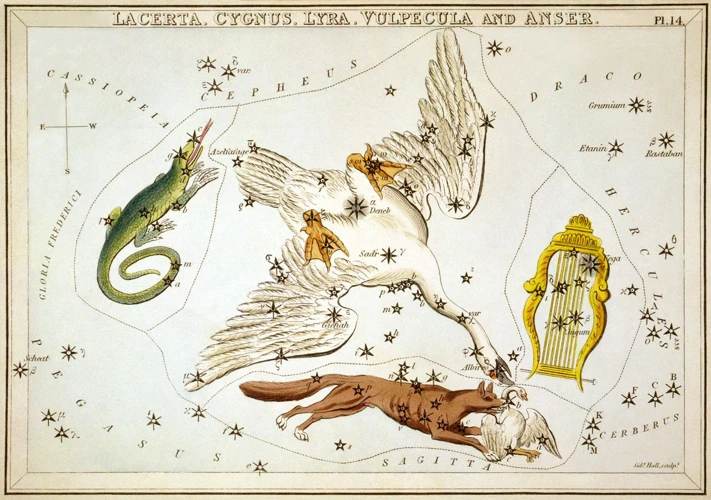
Delphinus the Dolphin is a small constellation located in the northern hemisphere. In Greek mythology, the constellation represents the dolphin that helped the god Poseidon in one of his adventures. According to the myth, Poseidon sent the dolphin to find Amphitrite, a sea nymph, and persuade her to marry him. The dolphin successfully brought Amphitrite to Poseidon, and as a reward for its service, Poseidon placed the dolphin among the stars.
Interesting Legends and Stories Across Different Cultures:
1. Native American Medicine Wheel: Some Native American tribes perceive Delphinus as a part of their Medicine Wheel, a sacred symbol representing the connection between the physical and spiritual worlds. They believe that the dolphin helps guide souls to the afterlife.
2. Chinese Mythology: In Chinese mythology, the constellation Delphinus is associated with a celestial river. The river is believed to be created by the tears of a mother who weeps for her lost child. The dolphin is seen as a messenger that carries the souls of deceased children across the river.
Astrophysical Exploration and Discoveries:
1. Binary Star System: Delphinus contains several binary star systems, where two stars orbit around a common center of mass. One notable binary system is Gamma Delphini, also known as Sualocin. Its name is the reverse of Nicolaus Venator, the Latinized name of Palermo Observatory director Niccolò Cacciatore, who first discovered the system.
2. Deep Sky Objects: Delphinus is home to several interesting deep sky objects, including the Delphinus Dwarf Galaxy. This dwarf galaxy, located approximately 7.2 million light-years away, is one of the closest galaxies to the Milky Way. It is a satellite galaxy of the larger Andromeda Galaxy.
Delphinus the Dolphin showcases the enduring beauty of mythology and the awe-inspiring discoveries of astronomy. By gazing at this constellation, we can reflect on the ancient stories that have been passed down through generations and appreciate the vastness of the universe.
Legends and Stories Across Different Cultures
Legends and Stories Across Different Cultures
Delphinus the Dolphin, a constellation located in the northern sky, holds a remarkable place in the mythology of various cultures. In Greek mythology, Delphinus is associated with the story of Poseidon, the god of the sea, and Amphitrite, a sea goddess. It is said that when Poseidon wanted to marry Amphitrite, she fled to the Atlas Mountains out of fear. To bring them together, Poseidon sent a dolphin to retrieve Amphitrite. The dolphin successfully persuaded her to return, and as a reward for its efforts, Poseidon placed the dolphin among the stars, immortalizing its loyalty in the form of the Delphinus constellation.
In other ancient civilizations, such as the Babylonians and Egyptians, the Delphinus constellation also holds fascinating tales. The Babylonians believed that the constellation represented the god Ea, who saved humanity by sending a flood to destroy wickedness. In Egyptian mythology, the constellation was associated with the goddess Isis, who was often depicted with a dolphin headpiece. She was revered as the goddess of magic, wisdom, and protection.
From Asia to the Americas, different cultures have their own stories and interpretations of the Delphinus constellation. In Chinese folklore, the constellation is known as “Wei,” the taming officer who controls floods and protects villages. Native American tribes, like the Huron and Ojibwe, saw the constellation as a group of beings that brought good luck, guiding them in their journeys and quests.
These diverse legends and stories surrounding Delphinus highlight the universal fascination with the night sky and the desire to weave narratives around the celestial bodies. Despite cultural differences, the shared appreciation for the stars unites us all, reminding us of our interconnectedness and the power of storytelling throughout history.
Astrophysical Exploration and Discoveries
Delphinus the Dolphin, a lesser-known constellation, harbors not only rich mythological tales but has also been a subject of astrophysical exploration and groundbreaking discoveries. In recent years, astronomers have delved into this celestial formation to uncover its hidden secrets and expand our understanding of the universe.
Through advanced observational techniques and space telescopes, scientists have made remarkable discoveries within Delphinus. One significant finding is the identification of exoplanets, or planets outside our solar system, within the boundaries of this constellation. These distant worlds offer glimpses into the diversity of planetary systems and the potential for habitability beyond Earth.
Astrophysical studies of Delphinus have revealed a variety of other intriguing phenomena. For instance, the constellation is home to numerous stellar nurseries, where new stars are born from vast clouds of gas and dust. These stellar nurseries provide valuable insights into the processes of star formation and the evolution of galaxies.
Additionally, Delphinus contains several notable variable stars, which are stars that exhibit fluctuations in brightness over time. These stars serve as valuable tools for measuring cosmic distances and understanding stellar evolution. By closely monitoring the changes in their brightness, astronomers can unlock valuable information about their properties and the underlying mechanisms driving their variability.
Scientists have also used Delphinus as a backdrop to study the phenomenon of gravitational lensing. This effect occurs when the gravitational pull of massive objects, such as galaxies, warps and bends the path of light from more distant objects behind them. By carefully analyzing the distortions in the light from background galaxies caused by gravitational lensing, astronomers can study the distribution and properties of dark matter, a mysterious substance that makes up a significant portion of the universe.
These astrophysical explorations and discoveries not only showcase the wealth of information hidden within lesser-known constellations like Delphinus but also highlight the essential role they play in expanding our knowledge of the cosmos. By venturing beyond the familiar and embracing the wonders of these lesser-known constellations, we can unlock new insights into the universe and marvel at the vast mysteries that continue to captivate us.
Conclusion

Conclusion:
As we conclude our exploration of lesser-known constellations, we have discovered a captivating world beyond the popular star formations. These hidden constellations, such as Vulpecula the Fox, Antlia the Air Pump, Columba the Dove, and Delphinus the Dolphin, hold stories that connect ancient mythology with modern astronomy. By venturing beyond the familiar, we not only gain a deeper appreciation for the vastness of the cosmos but also unearth the hidden tales and symbolism that have been woven into the night sky.
Through our journey, we have learned that there is beauty and significance in every constellation. Whether it’s the mythological origins and cultural significance of Columba the Dove or the ancient stories and astrophysical exploration of Delphinus the Dolphin, each lesser-known constellation provides its own unique perspective and adds to the tapestry of celestial wonders.
In our quest for knowledge and understanding, exploring these lesser-known constellations not only expands our understanding of the universe but also allows us to appreciate the rich heritage and scientific contributions of ancient civilizations. So, the next time you gaze up at the night sky, take a moment to look beyond the familiar constellations and uncover the hidden stories of these lesser-known celestial gems. They may just inspire you to see the stars in a whole new light.
References:
– /ophiuchus-constellation-story/
– /unraveling-book-dead-egyptian-mythology/
– /mythological-constellation-stories/
Frequently Asked Questions

1. How are constellations formed?
Constellations are formed by connecting groups of stars that appear close to each other in the night sky, creating a recognizable pattern or shape.
2. Are constellations visible all year round?
No, the visibility of constellations depends on the time of year and the observer’s location on Earth. Some constellations are only visible during specific seasons.
3. Can constellations change over time?
While the individual stars in a constellation remain relatively fixed, the perceived shape and position of a constellation can change over time due to Earth’s axial precession.
4. Are there constellations in both the northern and southern hemispheres?
Yes, there are constellations visible in both the northern and southern hemispheres, although some constellations may only be fully visible from one hemisphere.
5. How were constellations named?
Constellations were named by various civilizations throughout history, often drawing from mythology, folklore, or cultural significance.
6. Can constellations be seen in urban areas with light pollution?
Unfortunately, light pollution in urban areas can make it challenging to see fainter constellations. However, some brighter and more prominent constellations can still be observed even in areas with moderate light pollution.
7. Are there any famous stars within lesser-known constellations?
Yes, there are famous stars within lesser-known constellations. For example, Vulpecula the Fox contains the well-known star ‘Anser,’ Antlia the Air Pump features the bright star ‘Alpha Antliae,’ and Delphinus the Dolphin showcases the prominent star ‘Sualocin.’
While lesser-known constellations may not be as commonly used for navigation as the major constellations, they can still serve as reference points or be used in conjunction with other celestial objects for navigation purposes.
9. Are there connections between lesser-known constellations and astrology?
Astrology typically focuses on the twelve zodiac constellations, but some lesser-known constellations do have connections to astrology and can be referenced in astrological charts and interpretations.
Yes, astronomers are constantly studying various constellations, including lesser-known ones, to gain a deeper understanding of stellar evolution, exoplanets, and other astronomical phenomena. Ongoing space missions and telescopic observations contribute to the exploration of these constellations.
References
Frequently Asked Questions

1. Why are constellations important in astronomy?
Constellations are important in astronomy as they help astronomers locate and study celestial objects, such as stars, galaxies, and nebulae. They provide a framework for organizing the night sky and have been used for navigation and storytelling throughout history.
2. Are lesser-known constellations visible to the naked eye?
Yes, many lesser-known constellations are visible to the naked eye under the right conditions. While they may not be as widely recognized as popular constellations like Orion or the Big Dipper, they can still be seen in areas with low light pollution and clear skies.
3. How were the constellations named?
Constellations were named by ancient civilizations who saw patterns in the stars and associated them with mythological figures, animals, or objects. These names were passed down through generations and have been used for centuries to identify and study various areas of the night sky.
4. Can I see lesser-known constellations from different locations on Earth?
Yes, the visibility of constellations can vary based on your location on Earth. Certain constellations may be more visible from the Northern Hemisphere, while others are better observed from the Southern Hemisphere. Additionally, the time of year and the position of the Earth in its orbit can affect visibility.
5. What are some modern applications of studying lesser-known constellations?
Studying lesser-known constellations can provide valuable insights into the cultural, historical, and astronomical aspects of different civilizations. It can also contribute to our understanding of how ancient cultures navigated and interpreted the night sky, and provide inspiration for artistic and storytelling traditions.
6. Are there any scientific discoveries associated with lesser-known constellations?
Yes, scientific discoveries have been made through the exploration of lesser-known constellations. For example, the discovery of new stars, galaxies, and other celestial objects within these constellations has expanded our knowledge of the universe and contributed to ongoing astronomical research.
7. Can I create my own constellations?
While you cannot officially create new constellations within the recognized framework of modern astronomy, you can create and imagine your own patterns in the stars. Many cultures have created their own interpretations of constellations based on their own mythologies, stories, and traditions.
8. How can I locate and identify lesser-known constellations?
Locating and identifying lesser-known constellations can be done using star charts, astronomy apps, or by learning to navigate the night sky using recognizable stars and reference points. It can be a rewarding and educational experience for amateur astronomers and stargazers.
9. Are there any lesser-known constellations that are specific to certain cultures?
Yes, there are lesser-known constellations that are specific to certain cultures. For example, indigenous cultures may have their own constellations based on their mythologies and local traditions. Exploring these cultural-specific constellations can offer a unique perspective on astronomy and its connection to various human societies.
10. Can studying lesser-known constellations help us appreciate the vastness of the universe?
Absolutely! Studying lesser-known constellations can expand our understanding of the vastness and diversity of the universe. By exploring constellations beyond the popular ones, we gain a broader perspective on the night sky and the countless wonders it holds, fostering a sense of awe and appreciation.







